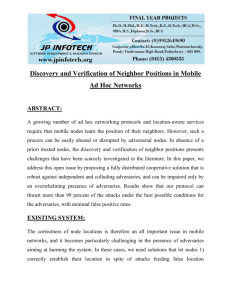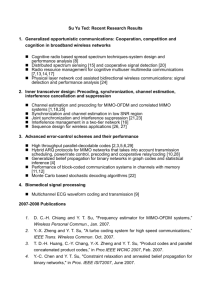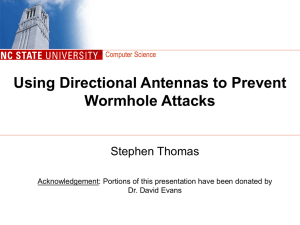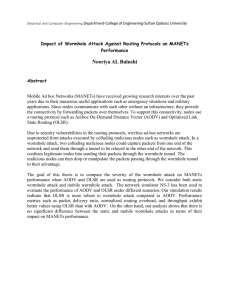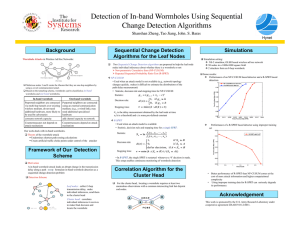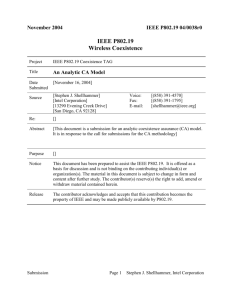Discovery and Verification of Neighbor Positions in Mobile Ad Hoc
advertisement
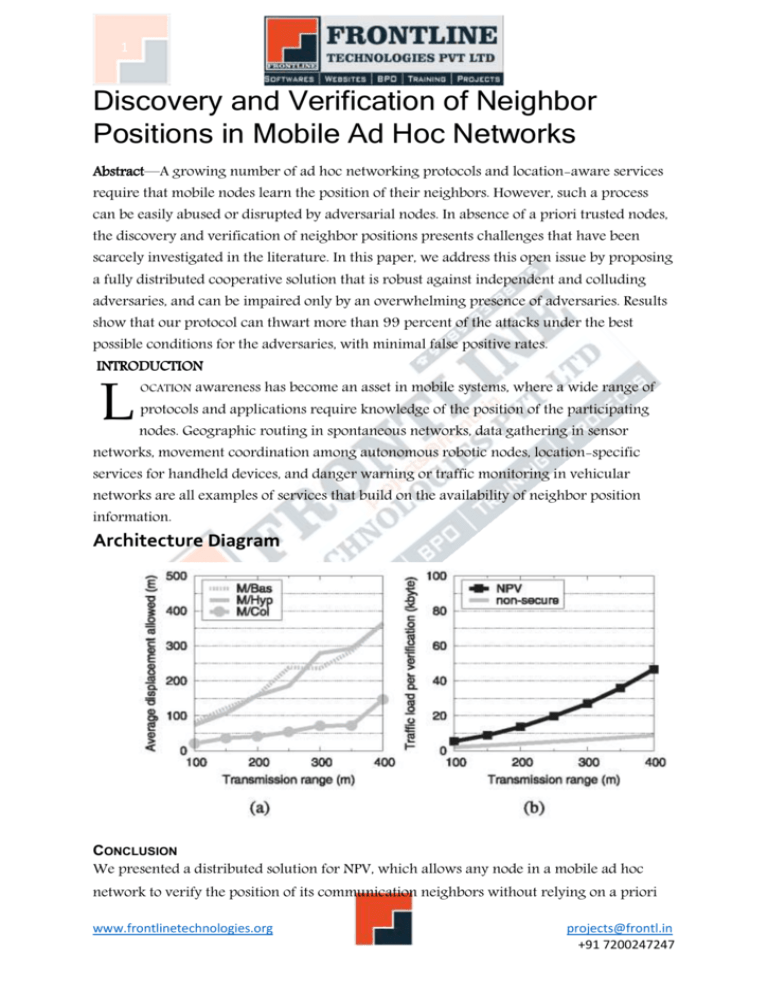
1 Discovery and Verification of Neighbor Positions in Mobile Ad Hoc Networks Abstract—A growing number of ad hoc networking protocols and location-aware services require that mobile nodes learn the position of their neighbors. However, such a process can be easily abused or disrupted by adversarial nodes. In absence of a priori trusted nodes, the discovery and verification of neighbor positions presents challenges that have been scarcely investigated in the literature. In this paper, we address this open issue by proposing a fully distributed cooperative solution that is robust against independent and colluding adversaries, and can be impaired only by an overwhelming presence of adversaries. Results show that our protocol can thwart more than 99 percent of the attacks under the best possible conditions for the adversaries, with minimal false positive rates. INTRODUCTION L OCATION awareness has become an asset in mobile systems, where a wide range of protocols and applications require knowledge of the position of the participating nodes. Geographic routing in spontaneous networks, data gathering in sensor networks, movement coordination among autonomous robotic nodes, location-specific services for handheld devices, and danger warning or traffic monitoring in vehicular networks are all examples of services that build on the availability of neighbor position information. Architecture Diagram CONCLUSION We presented a distributed solution for NPV, which allows any node in a mobile ad hoc network to verify the position of its communication neighbors without relying on a priori www.frontlinetechnologies.org projects@frontl.in +91 7200247247 2 trustworthy nodes. Our analysis showed that our protocol is very robust to attacks by independent as well as colluding adversaries, even when they have perfect knowledge of the neighborhood of the verifier. Simulation results confirm that our solution is effective in identifying nodes advertising false positions, while keeping the probability of false positives low. Only an overwhelming presence of colluding adversaries in the neighborhood of the verifier, or the unlikely presence of fully collinear network topologies, can degrade the effectiveness of our NPV. Future work will aim at integrating the NPV protocol in higher layer protocols, as well as at extending it to a proactive paradigm, useful in presence of applications that need each node to constantly verify the position of its neighbors. REFERENCES 1. 1609.2-2006: IEEE Trial-Use Standard for Wireless Access in Vehicular Environments - Security Services for Applications and Management Messages, IEEE, 2006. 2. P. Papadimitratos, L. Buttyan, T. Holczer, E. Schoch, J. Freudiger, M. Raya, Z. Ma, F. Kargl, A. Kung, and J.-P. Hubaux, "Secure Vehicular Communications: Design and Architecture," IEEE Comm. Magazine, vol. 46, no. 11, pp. 100-109, Nov. 2008. 3. P. Papadimitratos and A. Jovanovic, "GNSS-Based Positioning: Attacks and Countermeasures," Proc. IEEE Military Comm. Conf. (MILCOM), Nov. 2008. 4. L. Lazos and R. Poovendran, "HiRLoc: High-Resolution Robust Localization for Wireless Sensor Networks," IEEE J. Selected Areas in Comm., vol. 24, no. 2, pp. 233246, Feb. 2006. 5. R. Poovendran and L. Lazos, "A Graph Theoretic Framework for Preventing the Wormhole Attack," Wireless Networks, vol. 13, pp. 27-59, 2007. 6. S. Zhong, M. Jadliwala, S. Upadhyaya, and C. Qiao, "Towards a Theory of Robust Localization against Malicious Beacon Nodes," Proc. IEEE INFOCOM, Apr. 2008. 7. P. Papadimitratos, M. Poturalski, P. Schaller, P. Lafourcade, D. Basin, S. Capkun, and J.-P. Hubaux, "Secure Neighborhood Discovery: A Fundamental Element for Mobile Ad Hoc Networks," IEEE Comm. Magazine, vol. 46, no. 2, pp. 132-139, Feb. 2008. 8. Y.-C. Hu, A. Perrig, and D.B. Johnson, "Packet Leashes: A Defense against Wormhole Attacks in Wireless Networks," Proc. IEEE INFOCOM, Apr. 2003. 9. J. Eriksson, S. Krishnamurthy, and M. Faloutsos, "TrueLink: A Practical Countermeasure to the Wormhole Attack in Wireless Networks," Proc. IEEE 14th Int'l Conf. Network Protocols (ICNP), Nov. 2006. 10. R. Maheshwari, J. Gao, and S. Das, "Detecting Wormhole Attacks in Wireless Networks Using Connectivity Information," Proc. IEEE INFOCOM, Apr. 2007. www.frontlinetechnologies.org projects@frontl.in +91 7200247247
